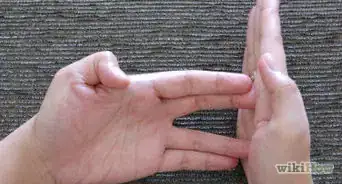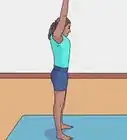This article was co-authored by David Engel. David Engel is a Muay Thai Instructor and Self Defense Trainer based in the San Francisco Bay Area. With over 15 years of martial arts instruction and training experience, David runs California Martial Athletics with co-owner Joe Chernay. He has created and maintained martial arts programs at Rise Combat Sports in San Francisco and Round 5 Martial Arts Academy in San Leandro, with a mission to provide students with a level of comfort and competency that manifests both within and outside the martial arts context. He is also a registered cornerman for amateur and pro competitors under the IKF (International Kickboxing Federation). David was the youngest apprentice instructor of the Thai Boxing Association of America under Ajarn Chai Sirisute (2009), and was a top-ranked amateur competitor in his weight class (127-130 lb) in California between 2013 and 2015.
This article has been viewed 129,312 times.
A butterfly kick is a kick commonly used in Wushu (Kung Fu).[1] It is called a butterfly kick because at the apex of the kick, all the limbs are extended out from the body similar to the wings of a butterfly stretched out in flight. This kick is a fundamental move that serves as a starting point for more difficult moves like the log roll, or log roll splits. Follow the steps outlined in this article to learn the kick safely and accurately.
Steps
Getting into Position
-
1Face the direction you want your kick to land. The butterfly kick is a rotating movement, so during the kick your head will be facing the opposite direction from your legs.
- Work out which direction you want your kick to land and then begin by facing that direction.
- Also work out if you want to travel from left to right, or right to left. In the explanation that follows, we will be traveling from right to left.
-
2Begin in bow stance. This stance, which is sometimes called forward or front stance, is the correct starting position for your kick.[2]
- Place your legs slightly wider than hip width apart.
- Place both feet at 45 degrees angles, as if at 2 o'clock on a clock face.
- Get into a lunging position. Your back leg should be straight, and your front leg bent at a 90-degree angle.
- Turn your hips in the direction of your front leg.
Advertisement -
3Extend your arms out. Placing your arms in the right starting position will allow you to build momentum for your rotation.
- While in bow stance, stretch the arm that corresponds to your straight leg in front of you with the shoulder by your ear.
- The arm that corresponds to your bent leg should be pointed behind you, with your upper arm close to the side of your torso.[3]
- Your hands should be flat with the fingers stretching away from your body in both directions.
Executing the Kick
-
1Pivot your feet. Footwork is important to execute the butterfly kick, here's how to get the footwork right.
- Starting from the bow position, pivot both feet 90 degrees. Do this by staying on the balls of your feet and lifting your heels off the ground.
- Shift your weight to the leg that was previously straight in the bow position.
- If you are traveling from right to left, you will therefore pivot your feet so that the toes point 45 degrees to the left.
- Bend the left leg and transfer most of your weight to it.
-
2Swing your arms for momentum. During the rotating movement, whip your arms as if drawing semi-circles in the air.[4]
- For example, the arm that was initially up by your ear in the starting position (in this case, the right arm), should end up stretched out behind you with the hand pointing down to the ground.
- Similarly, you should swing the arm that was initially stretched out behind you (in this case, the left arm) upwards. It should come to rest by your left ear.
- These arm movements give you vital momentum to take off with your kick.
- The direction is less important than maintaining good extension away from your body with the arms.
-
3Bend your body forward. As you are pivoting your feet and bending the left leg, bend your body forward, hinging at the hips so that your chest is parallel to the floor.[5]
- Make sure to keep your back straight as you bend forward.
- Maintaining a straight back gives the butterfly kick its distinctive look.
-
4Pivot 180 degrees on your left (standing) leg. As you began to pivot, you have transferred your weight to your left leg, which was initially the straight leg in bow stance.
- Keep pivoting until you execute a full 180-degree turn.
- At this point your head will be facing the back wall or the opposite direction that you were facing when you began your jump.
-
5Lift your right leg up and extend it out behind you. As you are pivoting with the left foot, kick your right leg out behind you.
-
6Jump off your standing leg and kick it out behind you. When you are mid-kick, all parts of the body are off the floor and your limbs are extended out from your body in a dynamic motion.
-
7Land on your right leg. Your left leg will come down after the right. Bend the landing leg and straighten the left leg and you will find you are in the same bow stance that you started in.
Finessing Your Kick
-
1Point your toes. As you are kicking, point the toes of both feet and extend your legs as much as possible. This will make your kick more aesthetically pleasing.
-
2Keep your head up. When you are rotating make sure that your chest stays parallel to the floor and that your head looks up.
- Fix your gaze on something ahead of you, this technique is called spotting.
- Imagine that you are locking eyes with your opponent.
-
3Practice. This is a relatively simple move, but it requires practice to build strength and accuracy. The more you practice the better, dedicate a few minutes per day and you will begin to notice improvement.
- Get a qualified person to spot you when you are just beginning. They can help by holding your arm and pulling you through as you rotate.[6]
- Practice with a wall bar to support your weight, to help you build up to the full kick.
Expert Q&A
-
QuestionHow can I improve the strength of my kick?
 David EngelDavid Engel is a Muay Thai Instructor and Self Defense Trainer based in the San Francisco Bay Area. With over 15 years of martial arts instruction and training experience, David runs California Martial Athletics with co-owner Joe Chernay. He has created and maintained martial arts programs at Rise Combat Sports in San Francisco and Round 5 Martial Arts Academy in San Leandro, with a mission to provide students with a level of comfort and competency that manifests both within and outside the martial arts context. He is also a registered cornerman for amateur and pro competitors under the IKF (International Kickboxing Federation). David was the youngest apprentice instructor of the Thai Boxing Association of America under Ajarn Chai Sirisute (2009), and was a top-ranked amateur competitor in his weight class (127-130 lb) in California between 2013 and 2015.
David EngelDavid Engel is a Muay Thai Instructor and Self Defense Trainer based in the San Francisco Bay Area. With over 15 years of martial arts instruction and training experience, David runs California Martial Athletics with co-owner Joe Chernay. He has created and maintained martial arts programs at Rise Combat Sports in San Francisco and Round 5 Martial Arts Academy in San Leandro, with a mission to provide students with a level of comfort and competency that manifests both within and outside the martial arts context. He is also a registered cornerman for amateur and pro competitors under the IKF (International Kickboxing Federation). David was the youngest apprentice instructor of the Thai Boxing Association of America under Ajarn Chai Sirisute (2009), and was a top-ranked amateur competitor in his weight class (127-130 lb) in California between 2013 and 2015.
Muay Thai Instructor & Self Defense Trainer To improve your strength, you're going to have to do more roadwork. Short distance sprints are really helpful, but you can also do lunges, or squats. If you have a weighted vest, you can add that for extra resistance. The best thing is to just get in some repetitions. The more you get the mechanics down, the less effort you will have to put into it.
To improve your strength, you're going to have to do more roadwork. Short distance sprints are really helpful, but you can also do lunges, or squats. If you have a weighted vest, you can add that for extra resistance. The best thing is to just get in some repetitions. The more you get the mechanics down, the less effort you will have to put into it. -
QuestionHow can I avoid the right leg getting stopped while in the air?
 Community AnswerThe best way is to set up your kicks with punches. There's no need to jump in the air because it kills balance and makes you vulnerable. Try doing a reverse version of the kick to keep an opponent surprised. Intercepting is the best way to combat.
Community AnswerThe best way is to set up your kicks with punches. There's no need to jump in the air because it kills balance and makes you vulnerable. Try doing a reverse version of the kick to keep an opponent surprised. Intercepting is the best way to combat. -
QuestionIt doesn't show what to do in the air. Is it just 2 swinging back kicks, like the reverse of front straight leg stretch kicks? Legs apart or together? Am I just spinning in air?
 Community AnswerTo do a basic butterfly kick in the water, you bring your hips up, allowing your legs to follow, then you allow your legs to fall down and repeat. You are basically doing the worm with your legs. You can do the butterfly kick on your back or stomach, and you can keep your legs together or a couple inches apart, if you are a beginner just do what feels comfortable. No, you are not spinning in the air.
Community AnswerTo do a basic butterfly kick in the water, you bring your hips up, allowing your legs to follow, then you allow your legs to fall down and repeat. You are basically doing the worm with your legs. You can do the butterfly kick on your back or stomach, and you can keep your legs together or a couple inches apart, if you are a beginner just do what feels comfortable. No, you are not spinning in the air.
Warnings
- Stretch well before doing this kick.⧼thumbs_response⧽
- Be careful, you can get injured doing this kick.⧼thumbs_response⧽
References
- ↑ http://factsanddetails.com/china/cat12/sub77/item281.html
- ↑ https://www.youtube.com/watch?v=psq3Nm-JHyQ&feature=youtu.be&t=19
- ↑ https://www.youtube.com/watch?v=psq3Nm-JHyQ&feature=youtu.be&t=21
- ↑ https://www.youtube.com/watch?v=psq3Nm-JHyQ&feature=youtu.be&t=25
- ↑ http://www.flashmavi.com/wushu_jumps_butterfly_kick_learn_xuanzi_XZ
- ↑ https://www.youtube.com/watch?v=psq3Nm-JHyQ&feature=youtu.be&t=66
About This Article
To do a butterfly kick, lunge in the direction you want to kick and point the arm corresponding to your bent leg backwards, stretching your other arm in front of you. Then, pivot your heels 90 degrees as you swing your arms for momentum and bend forward. Shift your weight onto your back leg and use it to pivot 180 degrees as you use your front leg to kick out behind you. Finally, jump with your back leg and use your front leg to stick the landing. For more tips on perfecting your kick, like how pointing your toes can help, keep reading!

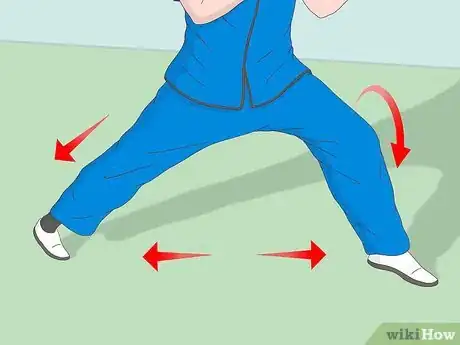
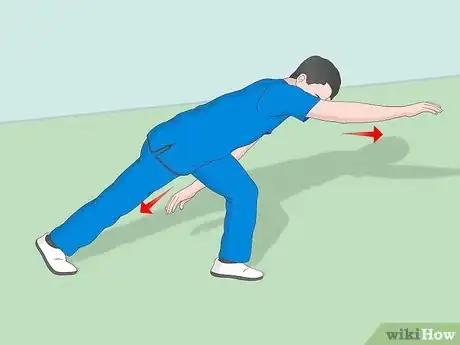
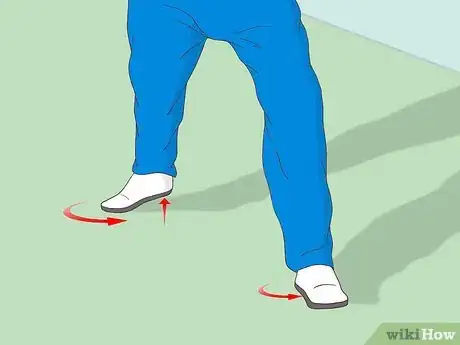
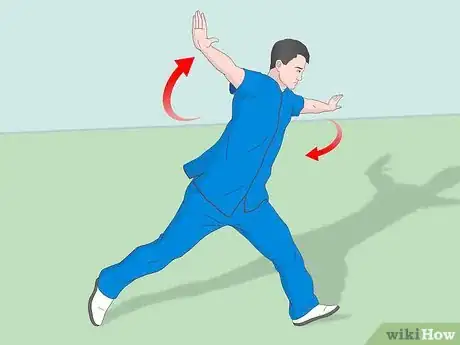

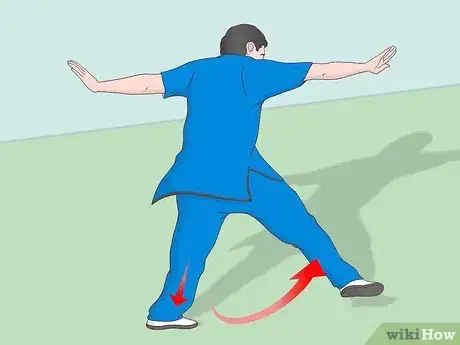
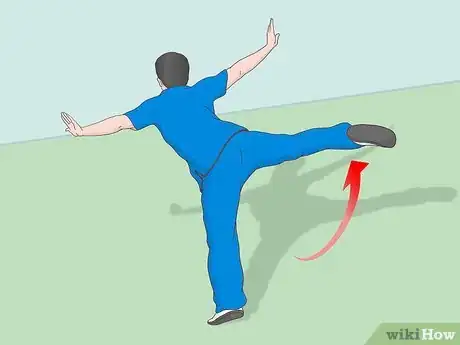
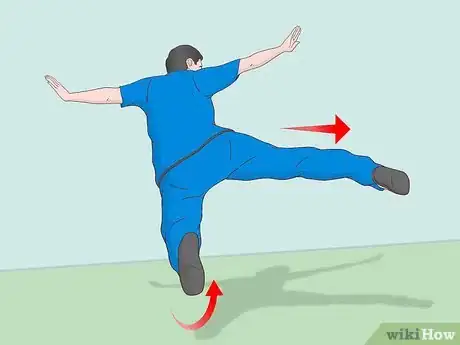
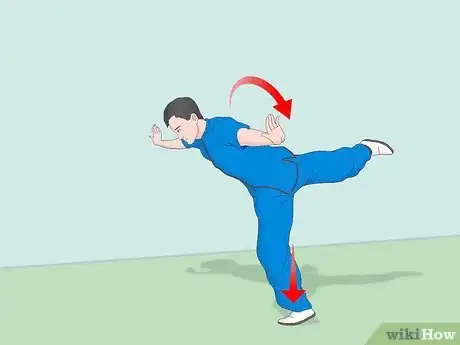
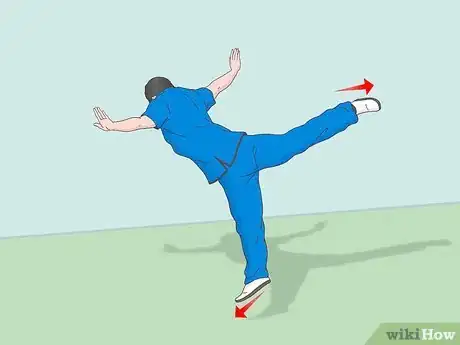
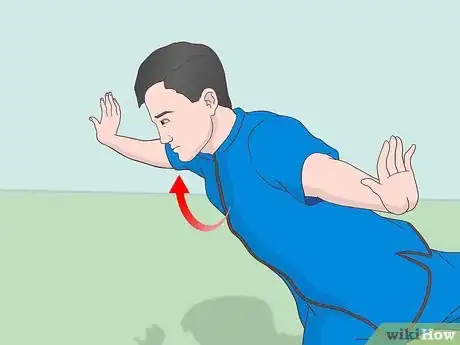

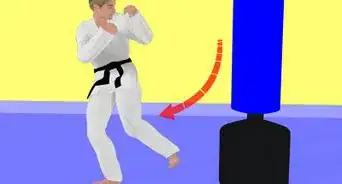



-Step-15-Version-2.webp)





